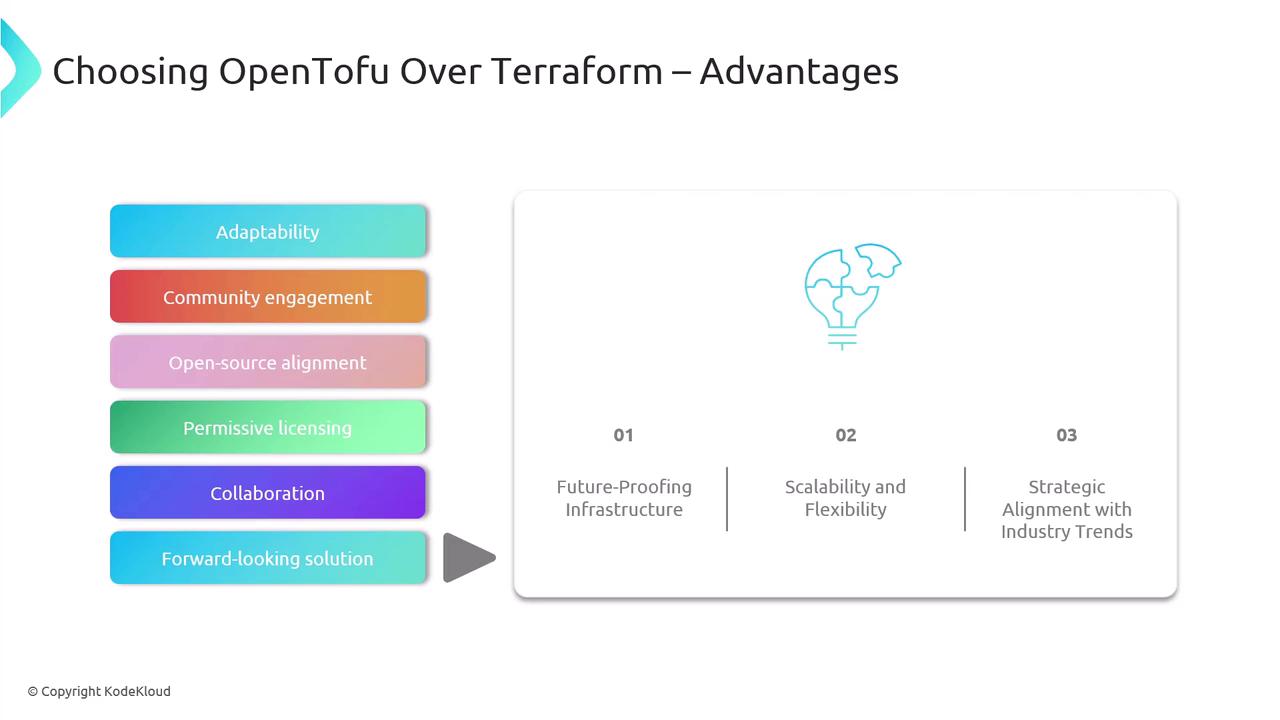OpenTofu: A Beginners Guide to a Terraform Fork Including Migration From Terraform
OpenTofu Beyond Basics
Why should you use OpenTofu instead of Terraform
In this comprehensive guide, we compare OpenTofu and Terraform across six critical dimensions—adaptability, community engagement, open-source alignment, licensing, collaboration, and scalability. Discover how OpenTofu can streamline your infrastructure-as-code (IaC) workflows and future-proof your deployments.
Comparative Overview
| Feature | OpenTofu | Terraform |
|---|---|---|
| Adaptability | Modular plugin system, rapid feature releases | Stable core, slower external plugin adoption |
| Community Governance | Fully transparent roadmap and decision-making | Community proposals with HashiCorp oversight |
| Licensing | Mozilla Public License (MPL) | MPL + proprietary enterprise modules |
| Collaboration Model | Inclusive RFC process, diverse contributor base | Centralized guidelines, select contributor access |
| Scalability & Future-Proof | Agile updates, designed for evolving workloads | Mature ecosystem, fewer major releases |
1. Adaptability
OpenTofu’s design prioritizes flexibility, enabling you to tailor your IaC setup with ease:
- Modular Architecture: Break your infrastructure into reusable modules and plugins.
- Cloud & On-Prem Support: Deploy consistently across AWS, Azure, GCP, or private data centers.
- Agile Release Cycle: Benefit from regular feature drops, timely bug fixes, and quick compatibility patches.
2. Community Engagement
A vibrant, user-driven community is the backbone of OpenTofu:
- Active Contributions: Features and fixes emerge from real-world use cases.
- Transparent Roadmap: Track issues, RFCs, and pull requests in the public repo.
- Feedback Loops: User suggestions directly influence prioritization and design.

3. Open-Source Alignment
OpenTofu embodies open-source principles—transparency, collaboration, and freedom:
- Community Governance: Public RFC process determines new features.
- Full Code Access: Inspect, fork, and enhance the codebase at will.
- Documentation & Support: Comprehensive docs and community forums ensure you’re never stuck.
4. Permissive Licensing
With a minimal license footprint, OpenTofu lowers legal barriers:
- Unrestricted Use: Integrate, modify, and redistribute without complex terms.
- Interoperability: Seamlessly combine with other open-source tools.
- Clear Legal Terms: Simple, well-documented MPL agreement.
Note
Review the Mozilla Public License (MPL) 2.0 to ensure it meets your project's compliance requirements.
5. Collaboration
OpenTofu’s inclusive development model accelerates innovation:
- Diverse Contributors: Operators, developers, and community advocates unite.
- Knowledge Sharing: Open discussions on best practices and architectural patterns.
- Continuous Iteration: Rapid cycles drive high-quality enhancements.

6. Future-Proofing and Scalability
Building your IaC on OpenTofu ensures long-term success:
- Resilient Management: Adapt to emerging cloud services and protocols.
- Elastic Workloads: Scale modules horizontally or vertically as needed.
- Strategic Advantage: Community-driven tools are increasingly preferred across industries.

Links and References
- OpenTofu GitHub Repository
- Terraform Documentation
- Mozilla Public License 2.0
- Infrastructure as Code Best Practices
Watch Video
Watch video content